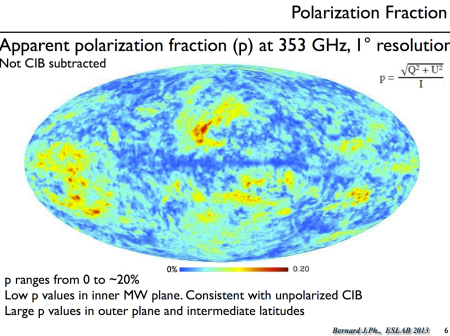Today’s hot issue in my favorite corners of the internet (at least, besides “What’s up with Solange?”) is the possibility that the BICEP2 discovery of the signature of gravitational waves in the CMB might not be right after all. At least, that’s the rumor, spread in this case by Adam Falkowski at Résonaances. The claim is that one of the methods used by the BICEP2 team to estimate its foregrounds (polarization induced by the galaxy and other annoying astrophysical stuff, rather than imprinted on the microwave background from early times) relied on a pdf image of data from the Planck satellite, and that image was misinterpreted.
Is it true? I have no idea. It could be. Or it could be completely inconsequential. (For a very skeptical take, see Sesh Nadathur.) It seems that this was indeed one of the methods used by BICEP2 to estimate foregrounds, but it wasn’t the only one. A big challenge for the collaboration is that BICEP2 only observes in one frequency of microwaves, which makes it very hard to distinguish signals from foregrounds. (Often you can take advantage of the fact that we know the frequency dependence of the CMB, and it’s different from that of the foregrounds — but not if you only measure one frequency.) As excited as we’ve all been about the discovery, it’s important to be cautious, especially when something dramatic has only been found by a single experiment. That’s why most of us have tried hard to include caveats like “if it holds up” every time we wax enthusiastic about what it all means.
However. I have no problem with the blog rumors — it’s great that social media enable scientists to examine and challenge results out in the open, rather than relying on being part of some in-crowd. The problem is when this perfectly normal chit-chat gets elevated to some kind of big news story. To unfairly single someone out, here’s Science NOW, with a headline “Blockbuster Big Bang Result May Fizzle, Rumor Suggests.” The evidence put forward for that fizzling is nothing but the Résonaances blog post, which consists in turn of some anonymous whispers. (Including the idea that “the BICEP team has now admitted to the mistake,” which the team has subsequently strongly denied.)
I would claim that is some bad journalism right there. (Somewhat more nuanced stories appeared at New Scientist and National Geographic.) If a reporter could talk to an actual CMB scientist, who would offer an informed opinion on the record that BICEP2 had made a mistake, that would be well worth reporting (along with the appropriate responses from the BICEP2 team itself). But an unsourced rumor on a blog isn’t news (not even from this blog!). As Peter Coles says, “Rational scepticism is a very good thing. It’s one of the things that makes science what it is. But it all too easily turns into mudslinging.”
We’re having a workshop on the CMB and inflation here at Caltech this weekend, featuring talks from representatives of both BICEP2 and Planck. I was going to wait to talk about this until I actually had some idea of what was going on, which hopefully that workshop will provide. Right now I have no idea what the answer is — I suspect the BICEP2 result is fine, as they did things other than just look at that one pdf file, but I don’t pretend to be an expert, and I’ll quickly change my mind if that’s what the evidence indicates. But other non-experts rely on the media to distinguish between what’s true and what’s merely being gossiped about, and this is an example where they could do a better job.



















